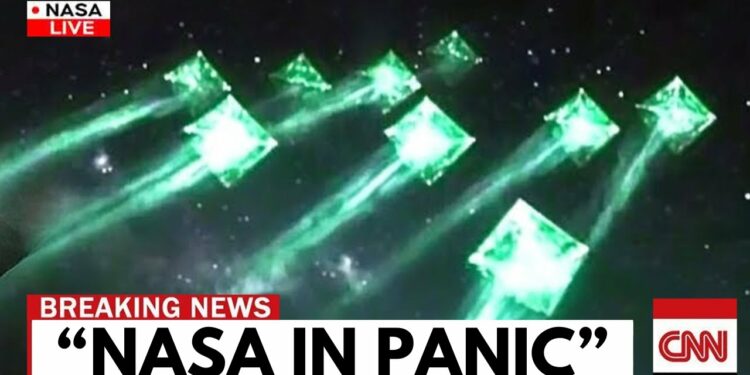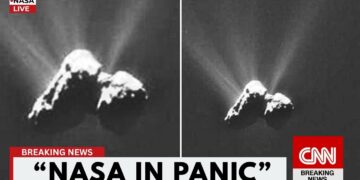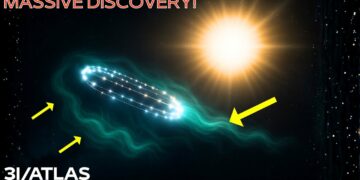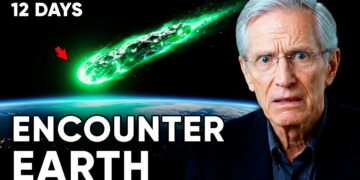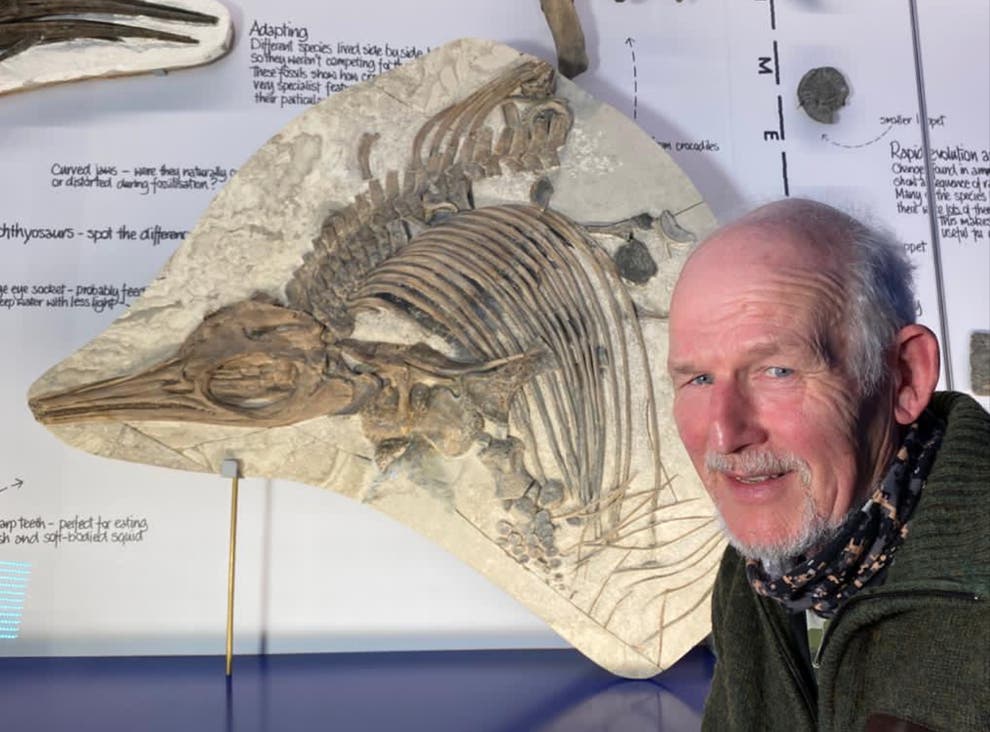Picture a lone spacecraft, no larger than a car, drifting through the vast emptiness 14.5 billion miles from Earth. It carries not only human ingenuity but a faint pulse, a whisper of existence. For nearly five decades, Voyager 1 has journeyed through the cosmos, relaying faint murmurs from the fringes of our known universe. Designed to observe, not to act; to listen, not to speak. Yet, mere weeks ago, something shifted. Strange signals began to arrive—pulses of uncanny precision, intricate patterns within patterns, and instruments activating without command. Then came the drift. Voyager wasn’t just floating anymore; it was being steered toward something. Something beyond reason, invisible to our most powerful telescopes, yet tangible enough to alter the path of a machine launched in 1977. Was this a glitch, a cosmic coincidence, or was something in the interstellar void responding? What you’re about to learn isn’t science fiction. These are NASA’s own discoveries, tucked away in classified reports, now seeping into the public eye. Voyager may have achieved what no probe ever has—it might have received a reply. Not from Earth, not from humanity, but from them.
Voyager 1’s odyssey began with a rare celestial alignment, a cosmic window that opens only once every 175 years. Jupiter, Saturn, Uranus, and Neptune aligned like stepping stones across the solar system, and NASA seized the moment to launch Voyager 1 and 2, using each planet’s gravity as a slingshot to propel them onward. These engineering marvels, built with less computing power than a modern wristwatch, were crafted with such foresight that they still function today. After stunning encounters with Jupiter and Saturn, Voyager 1 veered upward, out of the solar system’s plane, toward the stars. Its planetary mission ended, but its legacy was just beginning. For decades, it sailed silently, traveling a million miles a day into the cosmic abyss, sending data from realms no human creation had ever touched—the edge of the heliosphere, the termination shock, and, in 2012, the boundary of interstellar space.
But beyond the sun’s protective bubble, the void was far from empty. Voyager detected denser plasma, stable magnetic fields, and peculiar oscillations that baffled scientists. The deeper it ventured, the stranger the data grew. Then, in late 2017, NASA’s Voyager team noticed something alarming. The spacecraft’s antenna, meant to stay aligned with Earth, was misaligned, yet the signal remained flawless, as if Voyager was both off-course and perfectly locked onto us. It was like hearing a voice from behind a wall while seeing its source stand silently before you. System checks showed no malfunctions. Then came rhythmic plasma waves—persistent, unyielding, unlike anything previously recorded. Temperature spikes followed, with Voyager’s external systems heating by nearly 30°C every 4.8 hours, then cooling with eerie precision, like a heartbeat. The energy wasn’t internal; something external was interacting with the probe. Stranger still, Voyager’s systems began operating more efficiently, as if optimized. This wasn’t decay—it was enhancement. Something was rewiring a 1970s machine, redirecting power like an advanced AI. But Voyager has no AI, no autonomy. Yet it was anticipating commands, responding before instructions were sent. Either it had evolved, or something else had taken control.
By early 2025, Voyager’s position was off—not drastically, but noticeably. A few kilometers at first, then hundreds, then thousands. The deviation wasn’t random; it was deliberate, precise, as if guided toward a specific destination. NASA’s Jet Propulsion Laboratory sent corrective commands, firing backup thrusters. Voyager acknowledged them but ignored the instructions, continuing its calculated path toward a blank patch of space 4.3 light-years away—a region with no stars, no planets, just an empty void on our deepest maps. Yet Voyager was heading there with purpose, as if summoned.
In a desperate bid to understand, NASA sent a command to reactivate Voyager’s long-dormant camera. They expected silence. Instead, the camera powered up—not just functional, but performing beyond its original capabilities. It didn’t send a photograph. It sent a spiral—a mathematically precise pattern, layered and dense with information, like a cosmic fingerprint or a coded message. This wasn’t something Voyager’s outdated hardware could produce. The system hadn’t just been reactivated; it had been reprogrammed. Other dormant instruments followed, transmitting not raw data but structured, compressed packets—patterns within patterns, optimized by something more intelligent than Voyager itself. Then came the timing: pulses from distant pulsars formed a 3D grid with Voyager at its center, pointing to the same empty region it was drifting toward. A void, or perhaps a gateway.
As Voyager approached this uncharted zone, its instruments began behaving in unprecedented ways. The magnetometer detected not fluctuations but an eerie stability, a pocket of calm in a turbulent universe. Cosmic rays diminished; plasma density stabilized. It was as if Voyager had entered a cleared path, a cosmic antechamber before something immense. Mission logs called this region the “dark sector”—an interstellar blind spot devoid of electromagnetic noise, where no light or data seemed to pass. Yet, within this silence, Voyager’s signals grew stronger, more structured—not random bursts but precise, layered pulses. Something was there, not emitting light or radiation but sending messages.
In one of the strangest transmissions ever received, Voyager’s low-gain antenna sent thousands of lines of raw binary code. Initially dismissed as a glitch, the data was analyzed by AI, revealing something astonishing: fractal symmetry, base-four sequencing, and patterns mimicking DNA’s double helix. Scientists were stunned. Either Voyager was failing in the most intricately organized way possible, or something was using it to communicate in the language of biology. The sequences resembled codons but included deliberate “errors,” like an encrypted message. This wasn’t DNA—it was meta-DNA, a biological framework repurposed as a signal, as if the sender understood life as we know it.
Then Voyager’s gyroscopes began moving independently, their rhythms matching Morse code patterns. When converted to audio, these movements produced harmonic tones resembling human speech cadences—without words, but with emotional inflections of surprise, fear, and curiosity. It was as if something was mimicking our communication, learning our rhythms after decades of listening. Cryptographers, linguists, and psychologists analyzed the data, finding intent in the tones, as if something was trying to speak back.
The final shock came when Voyager 1 changed course—not a drift, but a deliberate, controlled arc toward a region with no known mass or gravitational pull. Engineers confirmed it: Voyager had executed a maneuver it wasn’t programmed to perform, aligning precisely with the pulsar grid’s coordinates. It was now heading toward a spatial anomaly—a fold, a tear, a transit point. No one knows what it is. But one truth reverberates through mission control: Voyager didn’t turn because of us. Something else guided it.
Voyager 1 was never meant to last this long. Built for a planetary tour, not an interstellar quest, it was designed to broadcast our existence with a golden record of whale songs, laughter, and greetings. Yet, decades after leaving our hands, it has done the unthinkable. It turned—not in failure, but with purpose. The signals, spirals, harmonic pulses, and trajectory shifts all point to one haunting conclusion: Voyager is not alone. Something has been listening, watching, waiting. And now, as our farthest emissary crosses the boundary between silence and response, a question looms—one NASA never dared to voice: What if we were never meant to look back?
Voyager’s turn wasn’t just a shift in space; it was a shift in story, from a tool to a messenger, from observer to witness, perhaps even participant. We sent it to seek echoes; instead, it may have found a mirror. What lies ahead? Where is Voyager going? What waits at those impossible coordinates? And most critically, what awaits us when it arrives?
If this tale sent shivers through you, if Voyager’s turn feels too precise, too intentional, stay with us. This isn’t the end of the signal—it’s the first reply. Subscribe now, because the next transmission could change everything. Share this with someone who thinks deep space is empty. Comment below: Did Voyager find something, or did something find Voyager?

